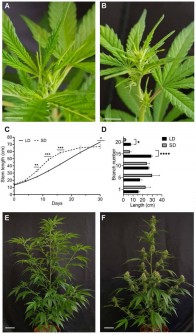Cannabis sativa L. has a wide range of applications, from fiber and seed oil production to medical and recreational use. A new study from the Volcani Institute in Israel, published in Horticulture Research on September 3, 2024, reveals critical insights into the factors influencing the growth and maturity of cannabis flowers. Understanding these mechanisms is crucial, as the shape and compactness of female flowers significantly affect yield and the concentration of bioactive compounds like THC and CBD.
The research team focused on the interplay between photoperiod and hormonal influences on cannabis flowering. While it is established that early flowering can occur independently of light cycles, the specific triggers for full floral maturation have remained largely unclear. Gibberellins, a group of plant hormones, have been recognized for their role in flowering control across various species, but their exact function in cannabis has not been well defined.
Key Discoveries about Flowering Mechanisms
Through a series of light cycle experiments combined with hormone treatments, the researchers found that short-day (SD) photoperiods initiate and sustain inflorescence development by maintaining low levels of gibberellins. Altering light conditions or externally applying gibberellins disrupted this balance, resulting in elongated stems and dispersed flowers. This research not only enhances the understanding of cannabis reproductive biology but also opens new avenues for agricultural optimization.
The study revealed a two-phase response to SD lighting in mature cannabis plants. Initially, plants experienced rapid stem elongation, but by day ten, internode elongation ceased, and compact flower clusters began to emerge. Declining levels of GA4 and auxin in the shoot apex correlated with this transition. Remarkably, the researchers discovered that just three days of SD exposure was sufficient to trigger inflorescence initiation; however, continuous SD was necessary to maintain it. Reverting to long-day (LD) conditions restored hormone levels, reversed floral clustering, and prompted a return to vegetative growth.
Further experiments indicated that applying gibberellins during SD conditions mimicked the effects of LD exposure, disrupting compact flower development and significantly lowering the levels of key cannabinoids like THC and CBD. Auxin treatments had minimal influence, underscoring the dominant role of gibberellin in this process.
Implications for Commercial Cultivation
The findings have substantial implications for cannabis cultivation, particularly in commercial settings. Understanding that continuous SD lighting is essential to maintain flower clusters equips growers with a powerful tool to precisely time flowering stages, thus avoiding disruptions that could compromise quality. Additionally, manipulating gibberellin levels offers a new strategy for controlling plant architecture and potentially enhancing cannabinoid yields.
Dr. Ben Spitzer-Rimon, the lead author of the study, emphasized the significance of the findings, stating, “Cannabis inflorescence development is a reversible, hormone-dependent process that requires a precise photoperiod. Our results show that even after flowers begin to form, returning to long days or increasing gibberellin levels can dismantle the process.” This insight is expected to transform how flowering stages are managed in cultivation, making cannabis production more predictable, controlled, and efficient.
As the global cannabis sector continues to expand, these insights will be pivotal in refining growth protocols and breeding strategies. The study not only contributes to the scientific understanding of cannabis but also provides practical applications for optimizing production in the pharmaceutical industry, where flower density and chemical consistency are critical.
In conclusion, the research conducted by the Volcani Institute sheds light on the complex hormonal interactions that govern cannabis flowering, paving the way for advancements in cultivation techniques. The integration of hormonal management and light cycle manipulation could lead to more efficient and reliable cannabis production, addressing the growing demands of both recreational and medical markets.






































































